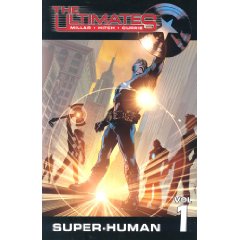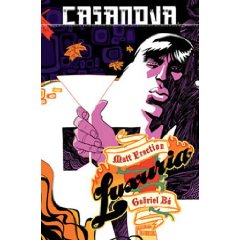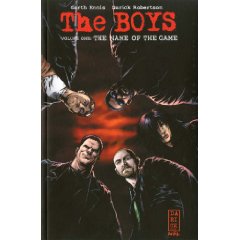The Ultimates vol. 1: Super Human
April 20th, 2009

Ultimates vol. 1: Super Human
Writer: Mark Millar
Artist: Bryan Hitch
The Ultimate Universe was devised by Marvel at the turn of the century in an effort to effectively jettison the 40+ years of continuity in the Marvel Universe proper without getting lynched by the armies of fanboys for whom continuity is basically sacred canon. The idea was simple: a complete reboot of the all of the familiar and cherished Marvel icons following them from day one all over again, watching them as they gain their powers, meet their respective super villains for the first time etc. To do this they brought in a raft of new and upcoming talent in order to kick things off with style.
In amongst this new pool of talent was Mark Millar, at that point most famous for his run on Wildstorm title The Authority, in which Millar presented readers with a group of sadistic murderers who bore uncanny likenesses to Marvel’s premiere superhero team, The Avengers. Had this been the early nineties Marvel probably would have sued Wildstorm and Millar until they cried, however, under the auspices of new Marvel Editor-in-Chief Joe Quesada, they instead gave him the keys to the kingdom. After successfully launching Ultimate X-Men and Ultimate Fantastic Four Millar was let loose on the slick new Avengers reboot they had planned. To whit: The Ultimates.
Teamed with artist and fellow Brit Bryan Hitch, Millar began to construct a new version of how the Marvel Universe’s biggest hitters came together, borrowing liberally from early Avenger stories from the Sixties and placing them in the context of the early 21st century. Add the polemical style for which Millar had already gained a reputation and with Hitch’s art (a man born to depict superhuman violence like no other) and you have The Ultimates.
Volume 1, comprising the first six issues of the series, starts in 1944 with the Allies launching an emergency raid on a Nazi nuclear facility with an exceptionally advanced missile trained on the U.S.A. This is of course the fateful mission where the Allies lose their secret weapon, Steve Rogers AKA Captain America. We are then introduced to the other main characters in the series in quick succession and given the premise of the series by Nick Fury in a conversation with Bruce Banner. Mutants and super humans are appearing all over the place: some such as the Fantastic Four seem benign, others, such as Magneto, do not. Therefore the U.S. government has freed up enough cash to bribe God with in order to establish a super-human deterrent force to defend against any known or future threats.
After this we are given a run through of everything that goes into making the team, from the ego clashes and personality defects of the team to the massive P.R. stunts employed to ensure public support of the Ultimates. Millar deftly flits between soap opera, polemic and knowing tribute, allowing cameos by real life celebrities and the then President of the United States and throwing in references to authors such as James Branch Campbell, before unleashing the all action finale as the team come together to take down their first real challenge in New York City, followed quickly with a truly shocking depiction of domestic violence that almost feels like it belongs in another comic.
But it is in the characterisation that Millar really excels, portraying each member of the team as massively dysfunctional, each with his or her own secrets, fears and foibles. His version of Captain America, for instance, having stepped from the 1940s, often seems utterly lost in the early 21st century, finding many of the ideas and attitudes he fought for seen as archaic at best. The Tony Stark of this universe is already a chronic alcoholic with serious doubts with regards to being a superhero. Thor is an anti-capitalist protester who was sent to the Earth to save its people from themselves – either that, or a Norwegian psychiatric nurse who had a mental breakdown and stole some classified European superhuman technology.
Bryan Hitch’s art throughout is extraordinary; bringing a level of detail that is astounding and consistent throughout, whether depicting conversations between the central characters, real life celebrities or demolition on a massive scale. Aided by brilliant colouring and inking, the artwork renders any complaints regarding the delays that became the series’ hallmark obsolete. Quality of this standard is worth waiting for at any time.
All in all, The Ultimates is very much a product of its time, much like the original Avengers, and manages to pay homage to the originals whilst also pushing the characters as far as they’ll go in the direction Millar wishes, creating a fun, well crafted story along the way. This is the best summer blockbuster you can read at the minute, and if Marvel Studios have any sense this is what the planned Avengers movie will look like. If you don’t believe me, just look at who’s signed up as Nick Fury.
Oh, and did I mention that the art is really, really good?
Paperback: 160 pages
Publisher: Panini (UK) Ltd. (10 Feb 2003)
ISBN-10: 1904159052

